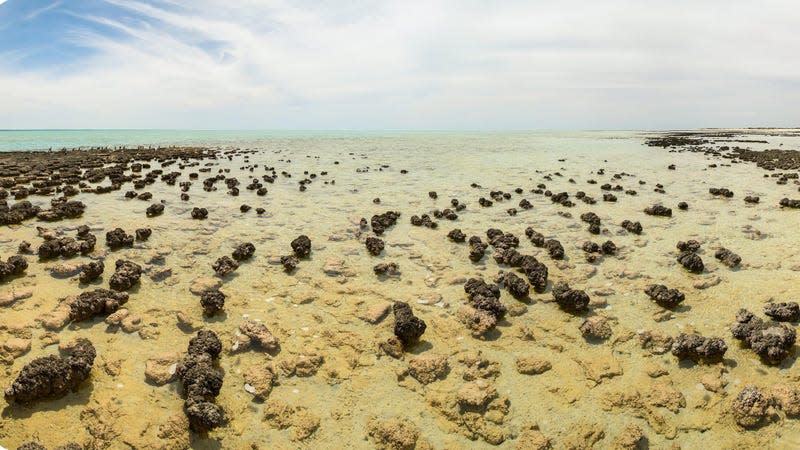1.75-Billion-Year-Old Fossils Are Oldest Record of Oxygenic Photosynthesis

Stromatolites in Western Australia’s Shark Bay.
The story of life on Earth can’t be told without photosynthesis, the process by which plants (and some other lifeforms) convert sunlight into chemical energy. Now, a team of researchers has announced the discovery of fossilized photosynthetic structures—the oldest yet known—from a staggering 1.75 billion years ago.
The structures belong to microfossils of Navifusa majensis, a presumed cyanobacteria found in northern Australia. Cyanobacteria are a type of microorganism that get energy from oxygenic photosynthesis, by which water and carbon dioxide are converted—using energy from sunlight—into glucose and oxygen. Thus, the ancient bacteria help scientists understand how one of the most fundamental life processes on Earth arose. The team’s research is published today in Nature.
Read more
These Are The Black Celebs Who Were Named On Jeffrey Epstein's List
A List of Comedians Katt Williams Threw Under The Bus on Shannon Sharpe’s Podcast
Wanna watch a smart woman totally body two stupid hockey men?
About a billion years after those oldest signs of life—and hundreds of millions of years before the microfossils studied by the team lived—Earth underwent the Great Oxidation Event, a point when oxygen was produced much faster than before. Exactly when oxygenic photosynthesis evolved in cyanobacteria in relation to the Great Oxidation Event is unknown.
Though the N. majensis studied by the recent team is younger than the oldest stromatolites, it puts another data point in the timeline of oxygenic photosynthesis. Previous research has pointed out that the bacterial lineages in which photosynthesis evolved may not be around today, so microfossils of such organisms are key for understanding how that evolution took place. Cyanobacteria are also thought to be the ancestor of chloroplasts in plants, making their fossils the perfect subjects for understanding photosynthesis’ origins.
Javaux’s team studied fossil assemblages from Australia, the Democratic Republic of the Congo, and the Canadian Arctic in the hopes that they could identify cyanobacteria from them. Though taxa like N. majensis have been known for a long time, Javaux said, their identification can be difficult due to their simple morphology.
The team identified the microstructures in N. majensis as thylakoids, a type of membrane-bound structure that exists in plant chloroplasts and some modern cyanobacteria. Thus, they determined that the minimum age for the split between cyanobacteria with thylakoids and those without them was roughly 1.75 billion years ago.
While the timeline of oxygenic photosynthesis now has another timepeg, the new findings don’t provide much insight into when photosynthesis evolved in relation to the Great Oxidation Event. However, more fossils like the thylakoid-bearing N. majensis could provide some answers.
More: Scientists See Photosynthesis Happening in Detail, Thanks to New Laser Technique
More from Gizmodo
Baldur’s Gate 3 Contains A Beautiful Tribute You’ll See Through Misted Eyes
Consumer Reports Says These Are The Best Hybrid Cars For Less Than $35,000 In 2024
Police Commissioner Says High-Speed Chase That Killed Driver Was ‘The Right Call’
Sign up for Gizmodo's Newsletter. For the latest news, Facebook, Twitter and Instagram.

